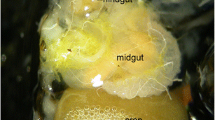Summary
Examination of the gut contents of adult Rhingia campestris reveals that there are considerable differences in the relative amounts of pollen and nectar ingested by individual insects. Pollen, a rich protein source, is required most by females, particularly during those stages of ovarial development when yolk deposition occurs. Nectar, which is mainly carbohydrate, is required in large amounts by males, and is also required by females before and after oogenesis. These results are discussed in relation to the likely nutritional needs of the flies, and it is suggested that similar feeding patterns may be found in a variety of other flower visiting insects. Finally, reference is made to the problems of making ecological assumptions about feeding behaviour on the basis of the morphological attributes of the mouthparts.
Similar content being viewed by others
References
Adams TS (1974) The role of juvenile hormone in housefly ovarian follicle morphogenesis. J Insect Physiol 20:263–276
Baker HG, Baker I (1973) Amino acids in nectar and their evolutionary significance. Nature 241:543–545
Boggs CL (1981) Nutritional and life history determinants of resource allocation in holometabolous insects. Am Nat 117:692–709
Boggs CL (1986) Reproductive strategies of female butterflies: variation in and constraints on fecundity. Ecol Ent 11:7–15
Boggs CL, Smiley JT, Gilbert LE (1981) Patterns of pollen exploitation by Heliconius butterflies. Oecologia 48:284–289
Fryer G (1988) Functional morphology and functional ecology. Funct Ecol 2:270–275
Harder LD (1985) Morphology as a predictor of flower choice by bumble bees. Ecology 66:198–210
Harlow PM (1956) A study of ovarial development and its relation to adult nutrition in the blowfly Protophormia terrae-novae (R-D). J Exp Biol 33:777–797
Haslett JR (1982) Feeding ecology and behaviour of some adult hoverflies (Diptera: Syrphidae). D Phil thesis, University of Oxford
Haslett JR (1989) Interpreting patterns of resource utilization: randomness and selectivity in pollen feeding by adult hoverflies. Oecologia 78:433–442
Hinton HE (1948) On the function, origin and classification of pupae. Proc S Lond Ent Nat Hist Soc 1947:111–154
Hinton HE (1977) Enabling mechanisms. Proceedings XV Int Cong Ent Washington: 71–83
Kotrschal K (1989) Trophic ecomorphology in eastern Pacific blennioid fishes: character transformation of oral jaws and associated change in their biological roles. Environ Biol Fish 24:199–218
Murphy DD, Launer AE, Ehrlich PR (1983) The role of adult feeding in egg production and population dynamics of the checkerspot butterfly Euphydryas editha. Oecologia 56:257–263
Percival MS (1961) Types of nectar in angiosperms. New Phytol 60:235–281
Schneider F (1958) Künstliche Blumen zum Nachweis von Winterquartieren, Futterpflanzen und Tageswanderung von Lasiopticus pyrastri L. und anderen Schwebfliegen (Syrphidae: Dipt.). Mitt Schweiz Ent Ges 31:1–24
Stanley RG, Linskens HF (1974) Pollen: Biology, Biochemistry, Management. Springer Berlin Heidelberg New York
Wiens JA, Rotenberry JT (1980) Patterns of morphology and ecology in grassland and shrubsteppe bird populations. Ecol Monogr 50:287–308
Author information
Authors and Affiliations
Rights and permissions
About this article
Cite this article
Haslett, J.R. Adult feeding by holometabolous insects: pollen and nectar as complementary nutrient sources for Rhingia campestris (Diptera: Syrphidae). Oecologia 81, 361–363 (1989). https://doi.org/10.1007/BF00377084
Received:
Accepted:
Issue Date:
DOI: https://doi.org/10.1007/BF00377084




